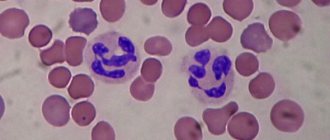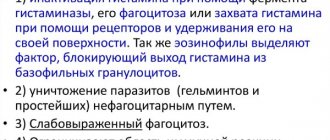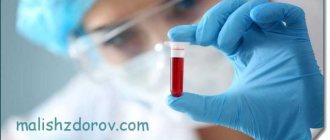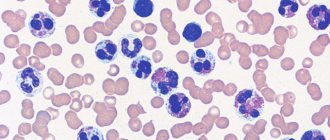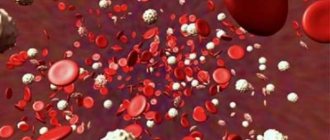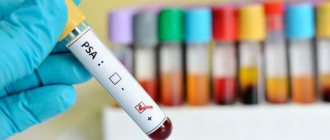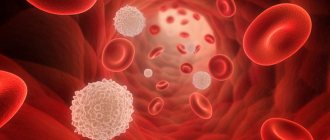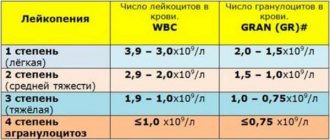Why does the body need eosinophils?
Each cell of our body plays its role. Now we will talk about eosinophils.
What are eosinophils?
Everyone knows that in our body there are erythrocytes (red blood cells) and leukocytes (white blood cells).
But few people know that leukocytes are also divided into:
- cells containing granules in the cytoplasm. These include basophils, neutrophils, eosinophils;
- cells that do not contain granules in the cytoplasm. Representatives of this group are monocytes and lymphocytes.
Thus, eosinophils are a type of leukocyte that contains granules.
What kind of granules are these? These granules are found in the cytoplasm. Therefore, when staining cells, they are the ones that give eosinophils their bright red color. What do eosinophil granules contain? Eosinophils contain a number of substances that ensure the performance of their functions. These include:
- main basic protein - promotes the destruction of parasites due to its toxic effect;
- cationic protein of eosinophils - also has toxic activity towards helminths, suppresses the synthesis of antibodies, helps in interaction with other cells;
- eosinophilic peroxidase – promotes the oxidation of substances, which results in the formation of reactive oxygen species. They, in turn, are capable of exposing the cell to death;
- eosinophil neurotoxin - exhibits its activity against viruses, activating cells of the immune system to develop an inflammatory response.
In addition to the fact that eosinophils have specific granules, these cells are capable of producing various signaling molecules. They are called cytokines. They ensure the functioning of cytokines at the site of inflammation and participation in the activation of the immune system.
Place of synthesis
All blood cells mature in the bone marrow. There, from the universal precursor cell, eosinophil maturation occurs (Figure 1).
Fig.1. Scheme of eosinophil maturation.
A mature cell, a segmented eosinophil, enters the bloodstream. If young forms are detected in the blood, this may indicate excessive destruction of eosinophils or the receipt of a large number of signals in the bone marrow to stimulate the formation of these cells.
A signal came to the bone marrow about the need for the synthesis of eosinophils, and after 4 days these cells are waiting for their turn to enter the bloodstream.
Eosinophils circulate in the blood for only a few hours, after which they go into the tissues and stand guard over order. They remain in tissues for about 10–12 days.
A small number of eosinophils are found in tissues that border the environment, providing protection to our body.
What functions do eosinophils perform?
It has already been said before what effects eosinophils can perform due to specific granules in the cytoplasm. But in order for eosinophils to be activated, that is, to release the contents of the granules, some kind of signal is required. Basically, this signal is the interaction of activators with receptors on the surface of eosinophils.
The activator can be antibodies of classes E and G, the complement system activated by helminth components. In addition to directly interacting with the surface of eosinophils, mast cells, for example, can produce chemotaxis factor, a compound that attracts eosinophils to that site.
Based on this, the functions of eosinophils include:
- participation in an allergic reaction. During an allergic reaction, histamine is released from basophils and mast cells, which determines the clinical symptoms of hypersensitivity. Eosinophils migrate to this area and promote the breakdown of histamine;
- toxic effect. This biological effect can manifest itself in relation to helminths, pathogenic agents, etc.;
- possessing phagocytic activity, they are able to destroy pathological cells, but neutrophils have a higher ability;
- Due to the formation of reactive oxygen species, they exhibit their bactericidal effect.
The main thing to remember is that eosinophils are involved in allergic reactions and the fight against helminths.
What to do if deviations are detected?
According to Evgeniy Olegovich Komarovsky, a famous Ukrainian pediatrician and leader of the medical program, fathers and mothers should not worry if, against the background of a slight increase in eosinophils, their children do not have any suspicious symptoms or complaints about the physiological condition.
It is necessary, without panic, to visit the pediatrician again and, if necessary, an infectious disease specialist, nutritionist or allergist, and ask any questions you may have. Most likely, the child may be prescribed a laboratory test of stool for helminthic infestation, as well as a biochemical blood test and testing for an allergic reaction.
If not a single diagnostic procedure has confirmed the presence of pathologies, then over the next 4–6 months you don’t have to worry about the baby’s condition. When the time comes, for the purpose of prevention, a control analysis should be performed again. Counting the number of eosinophils is carried out by people almost manually, so the human factor cannot be excluded either.
The normal level of eosinophils in the blood of a child
As mentioned earlier, eosinophils do not stay in the bloodstream for a long time. Therefore, healthy children should not have many eosinophils.
The numerical values of the norm depend on the method used to determine the number of cells. In old laboratories, the leukocyte formula is calculated manually, the result is given only in relative values, that is, in %.
Normally, in children under 4 years of age, the relative number of eosinophils should not exceed 7%. Over this age, the norm is the same as for adults - no more than 5%.
In modern laboratories, cells are most often counted automatically on a hematology analyzer, and only in exceptional cases are they counted manually. When counting cells on the analyzer, the result can be given in the form of relative and absolute values.
The absolute number of eosinophils reflects their exact number per liter of blood.
The absolute values of normal eosinophils are presented in the table.
Table. The norm of eosinophils in the blood of children.
| Age | Absolute quantities |
| Up to a year | 0.05 - 0.4 *10*9/l |
| One year - six years | 0.02 - 0.3 *10*9/l |
| More than six years | 0.02 - 0.5 *10*9/l |
Data with normal values are given for informational purposes only; you should not decipher the results of the analysis yourself!
Treatment
Treatment methods for children with an abnormally low level of special leukocytes in the blood are determined by the pathology that caused eosinopenia.
Along with the main therapy, drugs that enhance immunity are prescribed.
There are no specific measures aimed at restoring normal eosinophil levels.
A normal volume of special white blood cells in the blood is a sign of a healthy immune system. When a rapid reduction in these elements is detected, a set of therapeutic measures is prescribed by the doctor, taking into account all the results of the examination. The key specialist dealing with such problems is an immunologist. Based on the results of the diagnosis, he can redirect to an infectious disease specialist, parasitologist, endocrinologist and other doctors.
To reduce the risk of developing pathologies leading to a decrease in the number of eosinophils, it is necessary:
- Provide the child with a normal daily routine so that he has the opportunity to fully rest and get enough sleep. The duration of night sleep should be at least 8 hours;
- minimize stressful situations;
- maintain a healthy moral and psychological atmosphere in the family;
- promptly and completely treat pathologies that arise in the baby.
It is extremely important to maintain the child’s immunity at a high level.
For this purpose it is recommended:
- accustom him to daily morning exercises and hardening procedures;
- encourage sports;
- ensure that the baby’s nutrition is regular, correct and balanced;
- in agreement with the pediatrician, maintain the child’s health with periodic courses of multivitamin complexes.
It is noteworthy that in some cases the level of eosinophils returns to normal on its own. This happens if there has been psycho-emotional or physical stress.
Everyday care, sensitive and attentive attitude of adult family members towards the baby is the guarantee that he will grow up to be a healthy and happy person.
Indications for determining the level of eosinophils in the blood
Since eosinophils play an important role in allergic reactions and the fight against parasites, it is advisable to determine the level of these cells in the blood if these processes are suspected.
That is, the main indications for determining the level of eosinophils in a child’s blood may be:
- after eating some food product, itching began, dermatitis appeared on the skin, damage to the respiratory tract (coughing, sneezing, swelling of the larynx), and so on;
- headaches, poor perseverance of the child, insomnia may indicate the presence of parasites;
- low body weight with increased appetite may also indicate helminthiasis;
- the process of digesting food is disrupted, accompanied by changes in stool, vomiting;
- stomach ache;
- signs of deficiency of essential nutrients, despite adequate feeding of the child;
- Body temperature may rise.
If your child is crying, then something is bothering him, but he cannot tell you about it. Therefore, it is extremely important to understand what is happening to it and prevent the development of serious complications.
In addition to food allergies, it is possible to develop hypersensitivity to dust, animal hair, pollen, and even medications.
Reasons for the decline
Low levels of these formed elements often indicate the development of negative processes.
Causes:
- intoxication;
- infections in the acute phase;
- surgical procedures;
- glucocorticosteroid therapy;
- extensive burns;
- chronic lack of sleep;
- pregnancy;
- shock;
- acute inflammation;
- physical stress;
- porphyrite;
- sepsis;
- prolonged pain syndrome;
- stress;
- lack of interleukin-5;
A decrease in bone marrow function occurs when taking strong medications. In such cases, the production of leukocytes is significantly reduced, and complete eosinopenia is observed.
Increased work of the adrenal glands increases the level of corticosteroids and eosinophils decrease. Low levels of formed elements suggest the presence of an inflammatory process.
How to take the test correctly?
In order for the analysis result to be accurate and truly reflect what is happening in our body, we need to be properly prepared. Moreover, there is nothing complicated in preparing for this analysis.
First of all, both parents and the child need to prepare mentally. It is best for the child not to cry, not to panic, and to behave calmly. To do this, parents should explain to the baby what will happen in the hospital, that there is nothing wrong with it. Maybe you can even promise your child something in return if he behaves well.
It is also important to prevent your child from running around the hospital corridors while waiting for their turn in the blood collection room. Physical activity may affect study results.
Also, one of the most important rules for preparing for a blood test is that it must be taken on an empty stomach. If the child is already big (over 4 years old), then you can be patient and donate blood after an overnight fast. It is allowed to give the child water to drink.
It is recommended not to feed infants for 1 - 1.5 days before donating blood.
Blood is most often taken from the finger; in very small children, from the heel.
When preparing to donate blood, it is important to take prescribed medications. A number of medications can affect test results. Therefore, it is advisable to talk to your doctor about this. Don't do anything on your own!
Some medications can affect the level of the determined indicator. For example, Prednisolone can lead to a decrease in the level of eosinophils and monocytes in the blood.
If parents properly prepare for donating blood, they will not have to take the test again, plunging their child into a stressful situation.
Diagnostics
Eosinopenia is detected through a complete blood count.
The collection of biomaterial from a finger occurs in laboratory conditions, in the morning, on an empty stomach.
The last meal is allowed no later than 12 hours before the test, but drinking water is allowed.
The eosinophil level indicator is compared with other research data, on the basis of which conclusions are drawn about possible pathologies of the body.
However, a low level of special white blood cells is not a sign of a specific disease. In order for the doctor to make a diagnosis, the child must receive a full examination.
Interpretation of results
The interpretation of the results should be carried out by the attending physician who referred your child for a blood test. If the parents independently asked for a blood test, then deciphering the answer should be entrusted to a specialist. It may be located in the same place where the blood was donated, or you can contact your place of residence with a ready-made test result.
When eosinophils are elevated in a child and in an adult, this condition is called eosinophilia. Next we will look at situations where this is possible and why it occurs.
Diagnosis of eosinopenia
Eosinophils are low in an adult, what does this mean and what needs to be done to normalize well-being - diagnostics will tell you. Doctors often recommend that the patient undergo the following examinations:
- general urine analysis;
- general and biochemical blood test;
- ultrasound examination of the abdominal organs;
- thyroid hormone test;
- blood test for hepatitis and HIV;
- bacteriological culture of urine and sputum.
Often, the doctor recommends specific examinations to the patient depending on the inherent clinical picture. If the disease is of autoimmune origin, allergy tests are indicated.
Why are eosinophils in a child’s blood elevated?
There are a number of conditions when eosinophils are elevated in the blood.
- A worm entered the body, that is, helminthiasis occurred. Eosinophils migrate to the lesion, trying to get rid of the unwanted “guest”, thereby increasing their number in the blood. The most common parasites in children are pinworms and roundworms.
- Allergic reactions. In response to the penetration of an allergen into the child’s body, an immune reaction develops, during which various cells are activated. These include eosinophils. As mentioned earlier, they help break down histamine, an allergy substance. In order to confirm the presence of an allergic reaction, the level of eosinophils in the blood is determined. If the allergy is confirmed, they move on to searching for what could have caused it.
- Allergic diseases. This group includes pathologies such as bronchial asthma, hay fever and others. They are already “fixed” in the body, they are more difficult to get rid of than simple allergies.
- Hypersensitivity to drugs. It usually occurs immediately after administration of the drug. Such people then have to mention this throughout their lives when contacting a medical organization.
- Lefler's syndrome. This pathology is associated with the formation of an infiltrate in the lungs, which can be seen during a chest x-ray. In parallel, there is a high level of eosinophils in the blood. However, this pathology is very rare, most often in older people.
- Hypereosinophilic syndrome. This condition is accompanied by an excess amount of eosinophils in the blood and damage to the corresponding tissues. No parasites or allergic diseases are detected in the patient. What causes this condition remains unknown.
- Pathology of connective tissue. This includes: vasculitis, systemic lupus erythematosus, scleroderma and others. An increased level of eosinophils indicates the presence of a developing inflammatory process.
- Malignant neoplasms , for example, leukemia, can lead to eosinophilia.
- Polycythemia is accompanied by an increase in all blood cells, eosinophils are no exception. Diagnosing this disease is not difficult.
- Acute bacterial infections , infectious mononucleosis, tuberculosis can cause an increase in the level of eosinophils in the blood.
Drug therapy. Drug dosage regimen
If a child has elevated eosinophils in the blood, you need to contact an immunologist-allergist or a therapist to immediately begin drug treatment.
Below are the drug dosage regimens, taking into account the reasons and age category (dosages are designed for children):
- Antihistamines are prescribed for allergies of any origin, for example, Fenistil . It comes in the form of drops with a clear liquid for oral administration. Contraindicated in newborns up to one month old. From 1 month to 12 years, the daily dose is calculated as follows: 2 drops per 1 kg of patient’s body weight. The daily dose is divided into 3 doses, regardless of food intake. Children over 12 years of age take the drug in the same way, only the daily dose is increased to 20-40 drops at a time. If you feel drowsy, take the drug should be rescheduled closer to bedtime.
- Antihelmintic or antiprotozoal drugs are prescribed against parasitic worms. One of them is Nemozol, which destroys many common helminthiases. Such drugs should be taken with extreme caution, since they place an increased load on the body's filtering organ. That is why, along with Nemozol, drugs are prescribed to support the liver (for example, Essentiale Forte), and it is also recommended to take a biochemical blood test every 5 days and monitor the indicators (especially ALT, AST - aminotransferases, which show the functioning of the heart and liver). In case of any changes for the worse, it is necessary to stop treatment until everything returns to normal. There is no need to take any special restorative medications. In order to reduce the harmful effects on the gastrointestinal tract, Nemozol is taken after eating. For children weighing up to 60 kg, the dose is calculated at the rate of 15 mg per 1 kg of body weight and is taken in 2 doses once, and for children weighing more than 60 kg - 400 mg once. If the result is not achieved, the treatment should be repeated after a week or two. For trichinosis, the drug is taken 400 mg 2 times a day for 10-14 days. In severe cases associated with damage to internal organs by parasites, glucocorticosteroids are also taken.
- For eosinophilia of unknown origin or with complications in the form of tumors, necrosis, fibrosis, Gleevec is prescribed. This is a very strong drug that has shown excellent results in clinical studies. However, it has a huge drawback - a large number of side effects. In addition, there is little experience in using the drug on children. Gleevec should be used under the strict guidance of a physician who has previously worked with this drug. However, it is effective in the fight against HES (hypereosinophilic syndrome) and CEL (chronic eosinophilic leukemia), where the daily dose is 100 mg, which can be increased to 400 mg if necessary. Take until the disease disappears.
- For damage to internal organs and hypereosinophilia, prednisolone is prescribed at a dose of 1 mg/kg once a day. If the dynamics are positive, the dose is gradually reduced and adjusted by the attending physician.
https://www.youtube.com/watch?v=lbJ90CSZWGU
Regardless of the reasons for the increase in eosinophils in the blood, as well as in severe forms of eosinophilic bronchial asthma, Mepolizumab is used . The drug is administered intravenously in a volume of 100 mg every 4 weeks under the supervision of an experienced medical professional.
The dosage can be increased to 750 mg, but the safety of the drug in children remains not fully studied.
Actions of parents in case of eosinophilia in children
If elevated levels of eosinophils are detected, parents should consult a doctor. Since this is a “bell” that something is going wrong in the child’s body.
If it is confirmed that the child has a parasite, the doctor will prescribe medications to help remove it from the body. Do not drug your child without consulting a doctor!
If an allergic reaction is confirmed, it is important to identify its source. Then remove the child from contact with this allergen.
In general, in any case, consult a doctor, independence can aggravate the situation.
Possible complications
The long-term presence of eosinophilia, along with hypereosinophilic syndrome (HES) and chronic eosinophilic leukemia (CEL), can cause heart damage (the mechanism of migration to the heart is not fully understood). This complication occurs quite often and can lead to the death of the patient.
Infiltration of tissues by eosinophils causes damage to the lungs, central and peripheral nervous system, and brain, which, if not treated in a timely manner, can also lead to the death of the patient.
Symptoms in this case will be:
- memory impairment;
- cough and choking;
- convulsions;
- causeless changes in behavior;
- ataxia (erratic movement);
- muscle atrophy;
- intracranial hemorrhage.
In severe cases, an increase in this type of leukocytes in the blood indicates the presence of a secondary focus of malignant neoplasm and the irreversible process of death of part of the tissue (cancer with metastases and necrosis).
Thus, it is necessary not only to take eosinophils seriously, but also to begin to monitor their level in the blood, especially in children, and if pathological changes are detected (increase or decrease), immediately consult a doctor and begin searching for the root cause.
Author: Mary Elle
Article design: E. Chaikina

